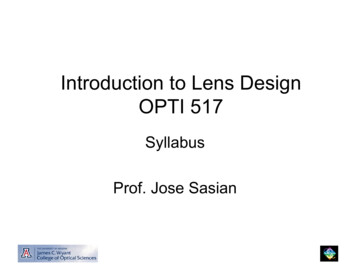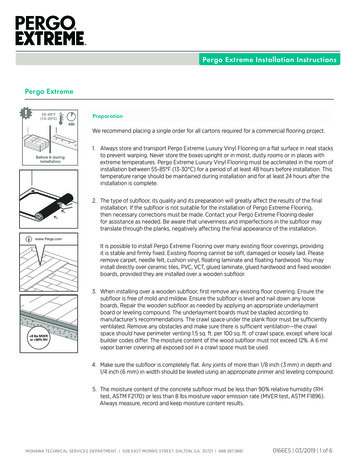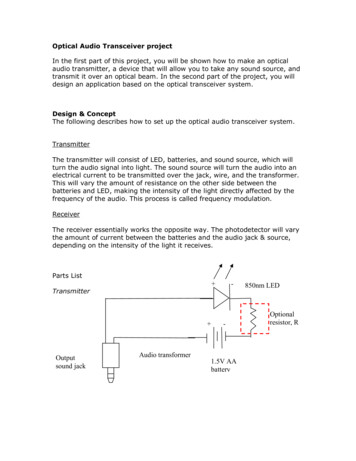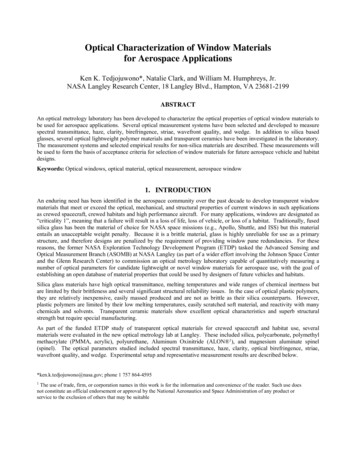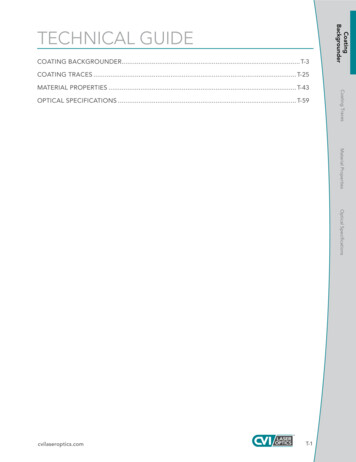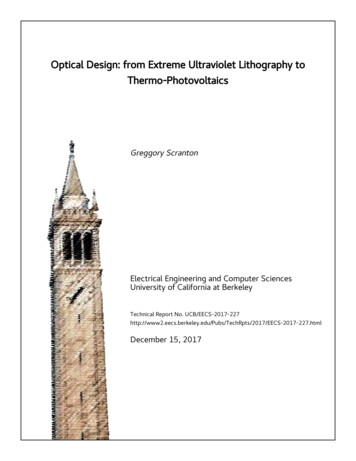
Transcription
Optical Design: from Extreme Ultraviolet Lithography toThermo-PhotovoltaicsGreggory ScrantonElectrical Engineering and Computer SciencesUniversity of California at BerkeleyTechnical Report No. s/TechRpts/2017/EECS-2017-227.htmlDecember 15, 2017
Copyright 2017, by the author(s).All rights reserved.Permission to make digital or hard copies of all or part of this work forpersonal or classroom use is granted without fee provided that copies arenot made or distributed for profit or commercial advantage and that copiesbear this notice and the full citation on the first page. To copy otherwise, torepublish, to post on servers or to redistribute to lists, requires prior specificpermission.
Optical Design: from Extreme Ultraviolet Lithography to Thermo-PhotovoltaicsByGreggory ScrantonA dissertation submitted in partial satisfaction of therequirements for the degree ofDoctor of PhilosophyinEngineering – Electrical Engineering and Computer Sciencesin theGraduate Divisionof theUniversity of California, BerkeleyCommittee in charge:Professor Eli Yablonovitch, ChairProfessor Ming C. WuProfessor Per PetersonFall 2017
Optical Design: from Extreme Ultraviolet Lithography to Thermo-Photovoltaics Copyright 2017Greggory ScrantonAll rights reserved
To my Parents
AbstractOptical Design: from Extreme Ultraviolet Lithography to Thermo-PhotovoltaicsbyGreggory ScrantonDoctor of Philosophy in Engineering–Electrical Engineering and Computer ScienceUniversity of California, BerkeleyProfessor Eli Yablonovitch, ChairAs optics and photonics technologies advance, more energy efficient use of lightwill be necessary. This dissertation presents methods developed to enhance the efficiencyof three different optical systems: extreme ultraviolet lithography, a hybrid solarphotovoltaic/thermal collection system, and thermo-photovoltaics.Extreme ultraviolet (EUV) lithography is the leading contender to become the nextindustrial scale lithography technology in the semiconductor industry. Traditionally,aberration correction in extreme ultraviolet projection optics requires the use of multiplelossy mirrors, which results in prohibitively high source power requirements. Thisdissertation analyzes a single spherical mirror projection optical system where aberrationcorrection is built into the mask itself through an adjoint-based optimization algorithm.This greatly reduces the power requirements for the source.Hybrid solar photovoltaic/thermal systems offer a way to convert sunlight intoelectricity and heat that efficiently uses different parts of the solar spectrum. Highlyefficient hybrid solar photovoltaic/thermal systems are enabled by recent advances inphotovoltaic technology. Record breaking photovoltaic cells have highly reflective rearmirrors to maximize luminescence efficiency. This reflectivity can also be used to createreflective optics to concentrate the reflected radiation onto a thermal absorber. Thisdissertation reports on a hybrid solar photovoltaic/thermal system with a thermal efficiencyof 37% at a maximum absorber temperature of 365 C, and a direct solar to electricefficiency of 8%.Thermo-photovoltaics offers a method to use photovoltaic cells to efficientlyconvert heat to electricity. In a thermo-photovoltaic system, light is collected byphotovoltaic cells from a local black body source. This dissertation reports on a thermophotovoltaic device that recycles unused radiation from the photovoltaics with a highlyreflective rear mirror. Theoretical efficiencies using this strategy are in excess of 50%. Foran emitter temperature of 1207 C, this dissertation reports an experimental powerconversion efficiency of 28.1%.1
Table of contentsAbstract . 1Table of contents . iList of figures . iiiList of tables . ixAcknowledgments. x1Introduction . 11Adjoint-based Optimization for Extreme Ultraviolet Lithography . 21.1Introduction . 21.2The Adjoint Method for Electromagnetic Design . 21.3The Adjoint Method Applied to ILT . 31.3.3Gradient with Respect to Electric Field . 61.3.4Gradient with Respect to Mask Transmission Factor . 71.424Results . 101.4.1Correcting Severe Spherical Aberration . 111.4.2Depth-of-Focus Optimization . 131.4.3Off-axis Aberration Correction . 151.5Angular Sensitivity Analysis . 171.6Conclusion. 18Hybrid Solar Photovoltaic and Solar Thermal Collection System . 192.1Opportunities enabled by highly reflective, high efficiency photovoltaics . 192.2Background for Hybrid Photovoltaic/Thermal Systems . 222.3Experimental Hybrid Solar Photovoltaic/Thermal System . 232.4Modeling Results. 272.5Considerations for High Temperature Photovoltaics . 282.6Experimental Results. 302.7Conclusion. 31Theory of Thermo-Photovoltaics. 334.1From Dyson Spheres to Thermo-Photovoltaics . 334.2Theoretical Efficiency . 35i
4.356History of Thermo-Photovoltaics . 39Experiments in Thermo-Photovoltaics . 415.1Introduction . 415.2Experimental Procedure . 415.3Calorimetry. 475.4Projections and Future Work. 48Conclusion . 52References . 54ii
List of figuresFigure 1 A flowchart showing one iteration in the adjoint method. First, electric and/ormagnetic fields are found for the current geometry through the forward simulation.Then, the geometry gradient is found through the adjoint simulation. The gradient isused to make an update to the geometry. 3Figure 2 Projection optics with one mirror (a), and an equivalent system with one lens(b). S is the distance from the mirror to the mask, and S' is the distance from themirror to the wafer (not to scale). D is the diameter of the mirror/lens. . 4Figure 3 An example Figure-of-Merit calculation at the wafer plane. The color mapshows electric field intensity. The desired pattern, Pd, is outlined by the black dashedline. The actual printed pattern, Pa, is outlined in cyan. The “error region”, Pd Pa , isshown in gray. This error region is integrated to obtain the Figure-of-Merit. . 9Figure 4 Illumination pattern. σx sinθx/NAW and σy sinθy/NAW. These six plane waveswere chosen to give the illumination some of the characteristics of an extendeddipole source, such as the one outlined in black. The four σx valuesare -0.8182, -0.2727, 0.2727, and 0.8182. The three σy values are -0.3099, 0, and0.3099. . 11Figure 5 (a) mask and (b) wafer plane intensity (normalized to clear field) for an opticalsystem with a naïve mask and no aberrations in the on-axis position. The pattern isperiodic, with one unit cell shown. The NA of the system is 0.33, thedemagnification is 4, and the wavelength is 13.5 nm. . 12Figure 6 (a) mask and (b) wafer plane intensity (normalized to clear field) for an opticalsystem with a naïve mask in the on-axis position. The pattern is periodic, with oneunit cell shown. The NA of the system is 0.33, the demagnification is 4, and thewavelength is 13.5 nm. The mirror radius is 15 cm. The image was taken at thecenter of the field. This naïve mask is used as the starting geometry for theoptimization. . 12Figure 7 (a) Mask and (b) wafer plane intensity (normalized to clear field) for an opticalsystem with an optimized mask. The simulation conditions are the same as in Figure6. With this optimized mask, all critical dimensions are within 5% of their target. . 13Figure 8 The same optical system as in Figure 7, with the mask pixelated. The pixels are14nm 15 nm. All critical dimensions are within 8% of their target. . 13Figure 9 (a) Mask and (b) wafer plane intensity (normalized to clear field) for an opticalsystem with a mask optimized to perform through 60nm of defocus. The simulationconditions are the same as in Figure 5. With this mask, all critical dimensions arewithin 7% of their target at focus, and remain within 11% through 60nm of defocus. 14iii
Figure 10 Bossung plots for the worst performing feature for the masks optimized (a) atfocus, and (b) for depth-of-focus. For the mask optimized through focus, all criticaldimensions remain within 11% of their targets for 60nm of defocus at nominal dose.The sharp jumps seen in the plots correspond to changes in the location of the worstperforming feature. . 14Figure 11 A diagram showing the three points on the wafer we designed masks for. Thewafer was assumed to be 33 by 26 mm. The mid-field point is displaced 6.5 mmfrom the optical axis and has 4000 wavelengths of coma and 230 wavelengths ofastigmatism (peak value, using the convention in Equation (1.8) ). The field edgepoint is displaced 1.3 mm and has 9000 wavelengths of coma, and 900wavelengths of astigmatism. 15Figure 12 (a) Mask and (b) wafer plane intensity (normalized to clear field) afteroptimization for the mid-field location 6.5mm off-axis. The mask resulting from theon-axis optimization was used as the starting mask for this optimization. All criticaldimensions are within 2% of their target. . 16Figure 13 (a) Mask and (b) wafer plane intensity (normalized to clear field) afteroptimization for the field edge location 13mm off-axis. The mask resulting from themid-field optimization was used as the starting mask for this optimization. Allcritical dimensions are within 3% of their target. . 16Figure 14 A diagram showing how the angular sensitivity, θ of an illumination planewave depends upon the magnitude of aberration phase shift on the lens of an opticalsystem. . 17Figure 15 Diagram of a solar cell at open circuit on an index-matched semiconductorsubstrate. Incident photons, shown in yellow, refract toward the normal uponentering the semiconductor due to the index mismatch with air. The incidentphotons are absorbed and re-emitted. The re-emitted photons have an energy equalto the bandgap energy of the semiconductor, and are shown in red. The re-emittedphotons tend to escape into the substrate before they can build up a high lightintensity. . 19Figure 16 Diagram of a solar cell at open circuit with a perfectly reflecting back mirror.In this case, the re-emitted photons are absorbed and re-emitted many times. Thiscauses the light intensity to build up inside the cell. The re-emitted photonseventually escape out the front of the cell. . 20Figure 17 Hybrid solar photovoltaic/thermal system. Direct normal irradiance from thesun is collected by the primary reflector, a parabolic concentrating mirror. This lightis concentrated onto a secondary reflector composed of gallium arsenide (GaAs)photovoltaic cells. The photovoltaic cells absorb the portion of the spectrum abovetheir bandgap, and reflect the remaining below-bandgap light. These cells arearranged in a parabolic shape around a high temperature absorber, so that theiv
reflected below-bandgap light is concentrated on the absorber. The absorbercontains a heat transfer fluid that is continuously pumped through it to transfer thethermal energy to where it can be harvested. . 24Figure 18 System components. (a) photograph of primary concentrator with structuralsupports for the secondary concentrator and absorber. (b) GaAs photovoltaic cellfrom Alta Devices. (c) Secondary concentrator and absorber inside evacuated glasstube, covered in GaAs photovoltaic cells. . 25Figure 19 Emissive power and emissivity of the high temperature absorber. The redcurve shows the emissivity/absorptivity of the absorber (data from Himin Solar Co.).The absorber is tailored be high in the low wavelength (high photon energy) regionto maximize absorption from the solar spectrum. The absorber is also tailored tohave a low emissivity in the long wavelength (low photon energy) portion of thespectrum, that overlaps with most of the blackbody spectrum for a temperature of500 C. The blue curve shows this blackbody spectrum. A low emissivity in thisregion prevents unwanted energy loss from the absorber via radiation. The effectiveemission from the high temperature absorber is shown in the green curve. . 26Figure 20 Photovoltaic cell and high temperature coating reflectivity verses blackbodyemission and AM 1.5 solar spectrum. The red curve depicts the AM 1.5 spectrum,representing solar radiation. The blue curve depicts the reflectivity of the GaAsphotovoltaic cells from Alta Devices used in the system, with constant extrapolationsfor the infrared and ultraviolet regions. The black curve depicts the reflectivity ofthe coating from Himin Solar Co. used on the high temperature absorber. The greencurve depicts the black body emission from the high temperature absorber. Allradiation spectra shown are normalized so that the maximum value is equal to 1. 27Figure 21 I-V curves for an Alta Devices GaAs solar cell at elevated temperatures under1 sun illumination. The active area of the cell is 8.53cm2 in area. Curves shown inreverse polarization, hence the negative current values. As the temperatureincreases, the semiconductor bandgap decreases. This has the effect of reducing theopen circuit voltage, and slightly increasing the short circuit current. As thetemperature increased from 25 C to 252 C, the open circuit voltage decreased from1.08V to 0.68V, and the short circuit current increased from 234mA to 265mA. Thecell area was 10cm2, so the corresponding short circuit current densities were23.4mA/cm2 and 26.5mA/cm2. Additionally, the fill factor decreased from 73.6% to49.7%. Overall the efficiency decreased from 18.6% to 8.9%. . 28Figure 22 Long-term experiments with an Alta Devices GaAs solar cell at elevatedtemperatures. (a) In this experiment, the cell was kept at 100 C under 10 sunillumination for 8 hours a day for 5 days. By the end of the experiment, the opencircuit voltage and short circuit current remained the same, but the fill factor under 1sun illumination had degraded by 3%. The 1 sun I-V curves before and after areshown here. (b) In this experiment, the same cell was kept at 150 C under 10 sunv
illumination for 8 hours a day for 5 days. By the end of the experiment, the opencircuit voltage and short circuit current remained the same, but the fill factor under 1sun illumination had degraded by an additional 28%. The 1 sun I-V curves beforeand after are shown here. . 29Figure 23 Thermal efficiency for the high temperature absorber. The thermal efficiency,ηsolar-thermal, is the percentage of direct normal incident light on the primary reflectorthat is converted into useable heat in the high temperature absorber. At themaximum output temperature of 365 C, ηsolar-thermal is 37%. Most other data pointsare near this efficiency. At the output temperature of 330 C, there is an anomalousdata point at the predicted efficiency of 47%. . 30Figure 24 An example of a Dyson sphere. Here, the radius of the sphere is oneastronomical unit, equal to 1.5 1011m. The sun emits a full black body spectrum ata temperature of 5777 Kelvin, and the portion of the spectrum below the bandgap ofthe photovoltaic cells is reflected back to the sun. . 33Figure 25 Thermo-photovoltaic system with reflective spectral control. In this system, ahot black body emitter is surrounded by a vacuum chamber. Photovoltaic cellslining the walls of the chamber collect light from the emitter. For high efficiency,highly reflective photovoltaic cells are used. They reflect unused radiation back tothe emitter so the energy is not lost. . 34Figure 26 A visual representation of how the blackbody spectrum is used in a thermophotovoltaic system with highly reflective photovoltaics. Most of the spectrum isreflected, as depicted in pink. Some of the below-bandgap radiation is parasiticallyabsorbed by the rear mirror, as shown in the orange region labeled “mirror losses”.Most of the above-bandgap radiation is available for conversion to electricity, asshown in the blue region labeled “photovoltaic power”. If no anti-reflection coatingis used, some of the above-bandgap radiation will be reflected. . 35Figure 27 Efficiency verses photovoltaic cell back reflectivity for Dyson spheres. A startemperature of 5777 Kelvin is assumed. A cell temperature of 20 C is assumed. Thephotovoltaic cell bandgap is optimized for each data point. Efficiency is calculatedaccording to Equation (4.6). . 37Figure 28 Heat to electricity conversion efficiency for a thermo-photovoltaic system. Inthis case, the emitter temperature is 1200 C, the cell temperature is 20 C, and theexternal luminescence efficiency is 30%. The efficiency is 42% at a cell reflectivityof 90%. The efficiency rises above 50% at a cell reflectivity of 98%. The efficiencyis 53% at a cell reflectivity of 99%. 38Figure 29 Heat to electricity conversion efficiency for a thermo-photovoltaic system. Inthis case, the emitter temperature is 1500 C, the cell temperature is 20 C, and theexternal luminescence efficiency is 30%. The efficiency is 46% at a cell reflectivityvi
of 90%. The efficiency rises to 50% at a cell reflectivity of 95%. The efficiency is57% at a cell reflectivity of 99%. . 39Figure 30 Experimental setup. A planar graphite emitter is heated by passing a largeelectric current through it. Beneath the emitter, a copper baffle is used to limit thearea of the photovoltaic cell exposed to the illumination. The photovoltaic cell isattached to a calorimeter that keeps its temperature steady, while allowingmeasurements of the heat generated in the cell. For our experiment, the baffle was1.44mm above the cell, the baffle was 1.04mm thick, and the emitter was 1.22mmabove the baffle. . 42Figure 31 structure of photovoltaic cell. The negative side of the p n junction is on top.The active layer is n doped, and is surrounded by selective contact layers. These aresurrounded by highly doped contact layers leading to gold contacts. . 42Figure 32 (a) Reflectivity spectrum of the InGaAs cell used in our experiment. Thisreflectivity spectrum was measured with a fourier transform infrared (FTIR)spectrometer. The measurement is an average over a range of angles, as themeasurement was taken through a microscope objective with a numerical aperture(NA) of 0.65. The below-bandgap reflectivity is 94%, and the averageabove-bandgap reflectivity is 34%, owing to the lack of an anti-reflection coating.(b) External quantum efficiency of the InGaAs cell used in our experiment. Theaverage above-bandgap value is 65%. All measurements are averaged over photonenergies. . 43Figure 33 current-voltage curves for the InGaAs cell at different emitter temperatures.The curve for the data point with the highest efficiency is shown in red. The currentdensity is the measured current divided by the cell’s active area of 10.04mm2. . 44Figure 34 Black body power absorbed by the InGaAs cell (blue), and electrical powerextracted from the cell (red). The power absorbed is calculated by multiplying themeasured reflectivity of the cell by the black body spectrum for the appropriateemitter temperature and view factor. The multiplied spectrum is then integrated.The power density is the power divided by the cell’s active area of 10.04mm2. . 45Figure 35 Thermo-photovoltaic efficiency at different emitter temperatures. Themaximum efficiency is 28.1% at an emitter temperature of 1207 C. The efficiencyis defined as the electrical power extracted divided by the power absorbed by thecell. This efficiency is given by Equation (4.6) together with Eq (5.1). . 45Figure 36 Short circuit current density from photovoltaic cell, and resulting calculatedemitter temperature. The emitter temperature was calculated from the cell’s shortcircuit current using Equation (5.2). A small copper sample is placed on top of theemitter. When the copper sample melts, the emitter is at a temperature of 1085 C.This is used to calculate the view factor, Fview 0.302. The current density is themeasured current divided by the cell’s active area of 10.04mm2. . 47vii
Figure 37 Calorimetry data. Absorbed power is plotted verses time. Absorbed power iscalculated with Equation (5.3). Two separate calorimetry experiments were done forpurposes of distinguishing between power absorbed by the cell and excess heatabsorbed by the calorimeter. In one experiment, the baffle hole was covered toprevent direct illumination from entering (orange). In the other experiment, an openbaffle was used with the InGaAs cell (blue). After 15 minutes, the emittertemperature was 1218 C, and the absorbed power by the cell was 137mW(1365mw/cm2). . 48Figure 38 Thermo-photovoltaic efficiency projection for increasing temperature.Experimental values are shown with the circular data points. The fit used for theprojection used device parameters that made the best fit to the empirical IV curve.These parameters are a series resistance of 0.47Ω, an ideality factor of 1.2, and areverse saturation current of I0 4.398nA. . 49Figure 39 Efficiency projection for increasing temperatures and improved deviceparameters. The curve labeled “projection using empirical parameters” is the samecurve shown in Figure 38. The next curve, labeled “RSeries 0.1Ω”, is a projectionthat uses the empirical parameters with the series resistance reduced to 0.1Ω. Thecurve labeled “Reflectivity 99%” uses the empirical parameters, with the seriesresistance reduced to 0.1Ω, and the reflectivity increased to 99%. The curve labeled“external luminescence efficiency 30%” uses the empirical parameters, with theseries resistance reduced to 0.1Ω, the reflectivity increased to 99%, and the externalluminescence efficiency increased to 30%. . 51viii
List of tablesTable 1 photovoltaic cell structure. The negative side of the pn junction is on top. Theactive layer is n doped, and is surrounded by selective contact layers. These aresurrounded by highly doped contact layers leading to gold contacts. . 43Table 2 Experimental data on electrical characteristics and absorbed power by thephotovoltaic cell at different emitter temperatures. The current density, JSC, and thepower densities are calculated by dividing the current or power by the cell’s activearea of 10.04mm2. . 46ix
AcknowledgmentsI would like to thank my advisor, Eli Yablonovitch, for his mentorship during mygraduate studies. Prof. Yablonovitch has a unique perspective that emphasizes simplifyingscientific ideas down to the fundamentals. This has made a wide array of scientific topicsmore approachable. I would also like to thank Professor Andrew Neureuther for valuablementorship on my work in extreme ultraviolet lithography. I am also grateful to JohnHolzrichter, Ed Pierce, and Professor Per Peterson for providing the vital lab space andequipment for my experiments in thermo-photovoltaics.I have had the opportunity to collaborate with many great co-workers during my timeat Berkeley. I would like to thank Vidya Ganapati for laying the theoretical groundworkfor my work in thermo-photovoltaics, and for passing down valuable knowledge from priorprojects. Samarth Bhargava has also provided valuable insight and criticism of my workthrough many a conversation. Patrick Xiao has also been a valuable collaborator to bounceideas off, and has contributed to the theory upon which this work is based. Patrick has alsobeen a great friend outside of work. I have also collaborated with an undergraduateresearcher, Simon Lorenzo, whose hard work was instrumental in obtaining experimentalresults. Zunaid Omair, who will be conducting future experiments, has contributedsubstantially in this regard as well.I would also like to acknowledge the moral support from my friends and colleaguesduring my time in graduate school, including Phil Sandborn and Indrasen Bhattacharya.x
1 IntroductionAs optics and photonics technologies advance, more energy efficient use of light willbe necessary. This dissertation presents methods developed to enhance the efficiency ofthree different optical systems: extreme ultraviolet lithography, a hybrid solarphotovoltaic/thermal collection system, and thermo-photovoltaics.Extreme ultraviolet (EUV) lithography is the leading contender to become the nextindustrial scale lithography technology in the semiconductor industry. Traditionally,aberration correction in extreme ultraviolet projection optics requires the use of multiplelossy mirrors, which results in prohibitively high source power requirements. If aberrationcorrection can be achieved with a different method, this could drastically reduce the powerrequirements. This dissertation analyzes a single spherical mirror projection optical systemwhere aberration correction is built into the mask itself through an adjoint-basedoptimization algorithm. Adjoint methods have been employed with a powerful effect inthe design of optical and photonic components [13]–[20]. This dissertation explores howthis method can be used to create sophisticated and unintuitive mask design
Optical Design: from Extreme Ultraviolet Lithography to Thermo-Photovoltaics by Greggory Scranton Doctor of Philosophy in Engineering-Electrical Engineering and Computer Science University of California, Berkeley Professor Eli Yablonovitch, Chair As optics and photonics technologies advance, more energy efficient use of light will be necessary.


